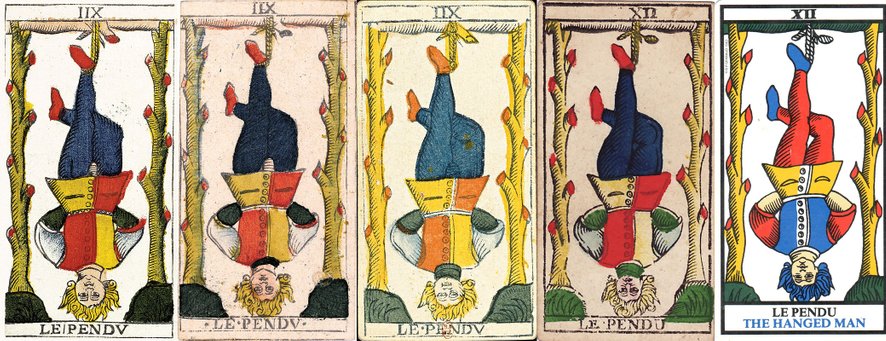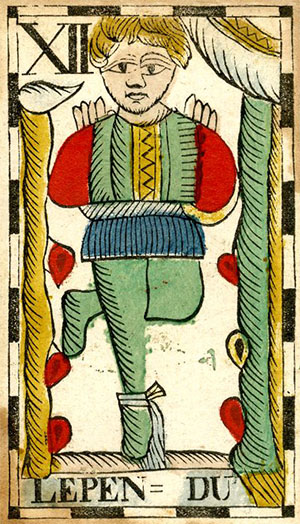THE TAROT WHEEL
THE DEVELOPMENT OF THE MARSEILLE TAROT
I don't like the name Marseille Tarot because the earliest development of the deck was elsewhere. The name was given in 1930 by Paul Marteau to a copy he made of an older deck created in Marseille, and published by the French card maker Grimaud, a company owned by Marteau. Let us compare one of the Grimaud cards with several decks belonging to the Marseille Tarot:
The card is the Hanged Man, numbered XII in the Tarot de Marseille. From left to right we have the following decks:
Pierre Madenie
François Chosson
François Tourcaty
Nicolas Conver
Grimaud
Dijon
Marseille
Marseille
Marseille
Grimaud
1709
1736 (the year is not very sure)
1745
1809 (using woodblocks dated to 1760)
1969 (international reprint of the 1930 deck)
The first three cards are practically the same, with some small differences, you almost need a magnifying glass to see them. Remark that the number XII is reversed, it is written IIX. This was common practice to emphasize the reversed position of the Hanged Man. Jaques Vievil started this tradition. Many people did not understand the reason of spelling IIX. Card makers in the Northern part of France (like Adam de Hautot) and in Belgium (like Nicholas Bodet and François-Jean Vandenborre) misunderstood Vievil and printed the card upside down. The card here at right is from the 1775/1780 Belgian Tarot deck of François-Jean Vandenborre.
The engraver who made the woodblocks used by Nicolas Conver knew evidently the other decks made in Marseille. For some of the details he follows François Chosson, but for other ones he is closer to François Tourcaty or to other decks not shown here. Nicolas Conver modernized the cards a little, instead of writing IIX he prefers using the official form XII. On the cards, the X stays in the center, the two I's move to the right, indicating that the original woodblock had been modified. Further, on the card is written PENDU instead of PENDV. Until around 1750, like in ancient Roman scriptures, the capital U was written as a V and the capital J was written as an I, so it was probably the original engraver who changed this.
Marteau most closely follows Nicolas Conver. Errors on the Conver deck (look for example between his upper legs and to the branch where the rope is attached) are reproduced in his own deck. In fact, he owned a Conver deck, so it is logical that he used this as a model. We also remark that Marteau does not respect the coloring of the cards, there are many differences. Especially the hanging figure has in detail no colors in common with the preceding versions.
We will not compare other cards here, but if we did, we would remark on all the cards the same kind of differences. The Grimaud deck is close to Conver, except for the coloring where Marteau follows his own ideas.
The Grimaud deck had a tremendous success, people rediscovered the old French Tarot cards. After 1930, every card deck produced in France in the same style, was called a Marseille Tarot, even when it was created outside Marseille. The oldest similar deck produced in Marseille, that is surviving, is the deck from François Chosson. We know now that there are older Marseille Tarot type decks who were produced in other cities like Paris, Lyon, Dijon and Avignon. Even if I dislike the name for historical reasons, we will use it for simplicity throughout these pages, or we use its abbreviation, TdM.
The following question is, why shall we describe the development of the Marseille Tarot? Its structure never changed, everybody copied each other. Even if there are differences, they are small. Well, this is not exactly true, there was some development. The cards presented above are all from the same generation, but here are two older generations in France. And except for these three versions of the French Marseille Tarot, we know of similar but older Italian cards, and we also know many variants inspired by the same source or by the Marseille Tarot itself elsewhere in France and all over Europe.
Let us first define what can be called the Marseille Tarot. The Marseille Tarot is a card deck that consists of 78 cards divided in 56 suit cards and 22 trump cards. There are four suits that are called DENIERS (Coins), COVPES (Cups) ESPEES (Swords) and BASTONS (Batons) with slight spelling differences possible. Except for the older cards, the name and the number are indicated in separate zones, respectively below and above the image. The images on the cards are usually a variation on the same theme, with some regional differences. Every suit has 10 pip cards and 4 court cards. The pip cards have from one to ten symbols and except for the Ace, a card that is never numbered, they can have a Roman number on one or both of their sides. Because card makers often made errors while engraving the numbers, the numbers used are II, III, IIII, V, VI, VII, VIII, VIIII and X. A number inversely printed keeps its value, so for example, IV and VI designate both the number six. We'll come back to this on the page about the numbered cards. The court cards are VALET (Page), CHEVALIER or CAVALIER (Knightn), ROYNE, REYNE or REINE (Queen) and ROY (King). The court cards are never numbered, the court has its own rules. The figures on the court cards have always the same pose. The names and numbers of the Trump cards are as follows
I
II
III
IIII
V
VI
VII
VIII
VIIII
X
XI
XII
XIII
XIIII
XV
XVI
XVII
XVIII
XVIIII
XX
XXI
LE FOU, LE FOL or LE MAT (the Fool, no number, 0 or XXII when numbered)
LE BATELEVR (the Conjurer)
LA PAPESSE (LA PANCES) (the Popess)
LIMPERATISE (the Empress)
LEMPEREVR (the Emperor)
LE PAPE (the Pope)
LAMOUREUX (the Lover)
LE CHARIOT (the Wagon)
IVSTICE (Justice)
LERMITE (the Hermit)
LA ROVE DE FORTVNE (the Wheel of Fortune)
FORCE (Strength)
LE PENDV (the Hanged Man)
Almost never had a name, LA MORT (Death) if any.
TEMPERANCE (Temperance)
LE DIABLE (the Devil)
LA MAISON DIEV (the God House)
LESTOILLE (the Star)
LA LVNE (the Moon)
LE SOLEIL (the Sun)
LE IVGEMENT (the Judgement)
LE MONDE (the World)
Again, spelling differences exists and the space between words is not always respected. Sometimes the space is indicated by a point or more rarely by a vertical line. The numbers on the card don't give them a value, they are only there for clarifying the order of the trumps. The images are always the same, although Death and the Emperor may be mirrored between different decks. Some images have a similar scenery but with differences in details.



